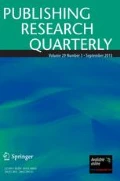Abstract
University presses select and publish intellectually significant scholarship. As they each occupy disciplinary space, particular to their publishing and editorial missions, university presses consider manuscripts per respective brands and imprimatur. This presentation will examine subject specialization within the larger context of disciplinary formation and disciplinary alignments university presses consider within their purview. To gain a greater appreciation of their missions in subject specialization, a definitional model will animate further discussion of publication trends, and disciplinary nomenclature utilized by university presses to capture their emphases within the constellation of scholarly publishing. Methodology and discussion will focus on data gleaned from the 2018 Directory of Association of American University Presses. Via a bibliometric approach, comparison with earlier Directories will situate discussion within the wider frame of disciplinary specialization growth. Disciplinary subjects and disciplinary nomenclature will constitute the focus of discussion as central to university press monographic publication trends. Special emphasis and illustrations will focus on fragmentation, hyper-specialization, and trends accommodating emerging scholarly domains, especially disciplinary permeability. Further broached vis-à-vis academic publishing and corresponding influence on scholars, especially, humanities scholars, as they navigate the scholarly communication system, exemplified by university presses.




Similar content being viewed by others
Notes
See Chester Kerr, A Report on American University Presses (New York: AAUP 1949); C.M. Jagodzinski, “The University Press in North America: a Brief History,” Journal of Scholarly Publishing 40 (2008): 1–20; J.S. Meisel, “American University Presses, 1929–1979: Adaptation and Evolution.” Book History 13 (2010): 122–53.
See Paul Parsons, “Specialization by University Presses,” Book Research Quarterly 6, 2 (Summer 1990): 3–15; Edward A. Goedeken, Jean-Pierre V. M. Hérubel, “Two sides of the Same coin? Trade and University Press Publishing of Revised Dissertations, 2007–2016: Some Observations.” Publishing Research Quarterly (2018): 170–206; Jean-Pierre V. M. Hérubel, Edward A. Goedeken. “University Presses and Emerging Disciplinary Configurations and Orientations: An Exploration and Discussion.” Publishing Research Quarterly 35 (March 2019):39–51.
See Jean-Pierre V.M. Hérubel, “Clio’s View of the History of Science: A Preliminary Bibliometric Appreciation,” Behavioral and Social Sciences Librarian 24, 2 (2006): 69–91.
Raw data gleaned from Association of American University Presses (AAUP), Directory (New York: AAUP 2007). The Subject Grid is available at http://www.aaupnet.org/resources/AAUPGrid2007.pdf; other years were made available in hard copy.
A. Abbott. Chaos of Disciplines (Chicago: University of Chicago Press, 2001).
Jean–Pierre V. M, Hérubel, Edward A. Goedeken, “University Presses and Emerging Disciplinary Confgurations and Orientations: An Exploration and Discussion.” Publishing Research Quarterly 35 (2019):39–51.
Becher T, P.R. Trowler. Academic Tribes and Territories: Intellectual Enquiry and the Cultures of Disciplines. (Buckingham: Open University Press; 2001); Pierre Bourdieu. Homo Academicus, trans. (Palo Alto: Stanford University Press; 1984); Pierre Bourdieu. Pascalian Meditations, trans. (Cambridge: Polity Press, 2000).
T. Bender, C.E. Schorske. American Academic Culture in Transformation: Fifty Years, Four Disciplines (Princeton: Princeton University Press, 1998); Michele Lamont. How Professor Think: Inside the Curious World of Academic Judgment (Cambridge, MA: Harvard University Press, 2009).
See, Jean-Pierre V.M. Hérubel, “Musings on Disciplinary Morphology and Nomenclature in the Humanities and Social Sciences: implications for Book Selection,” Journal of Scholarly Publishing 39 (2007): 318–26; Jean-Pierre V.M. Hérubel. Disciplinary Morphologies, Interdisciplinarities: Conceptualizations and Implications for Academic Libraries. In: Mack DC, Gibson C, editors. Interdisciplinarity and Academic Libraries: ACRL publications in Librarianship No. 66. Chicago: ACRL; 2012. p. 17–53.
A helpful aside is Donald Campbell, "Ethnocentrism of Disciplines and the Fish-Scale Model of Omni- science." In Interdisciplinaty Relationships in the Social Sciences, edited by Muzafer Sherif and Carolyn Sherif, (Chicago: Aldine, 1969). 328–48.
See Anne L. Buchanan and Jean-Pierre V.M. Hérubel,”Interdisciplinarity: The Case of Historical Geography through Citation Analysis,’ Collection Building 14, 2 (1994): 15–21; Jean-Pierre V.M. Hérubel and Anne L. Buchanan, “Disciplinary, Interdisciplinary, and Subdisciplinary Linkages in Historical Studies Journals,” Science and Science of Science 3, 3 (1994): 15–24; Anne L. Buchanan and Jean-Pierre V.M. Hérubel, ‘Interdisciplinarity in Historical Studies: Citation Analysis of the Journal of Interdisciplinary History,” LIBRES: Library and Information Science Research Electronic Journal 4, 2/3 (1994): 1–13.
For the genesis of this see, L. Veysey, “The Plural, Organized World of the Humanities. In: Oleson A, Voss J, editors. The Organization of Knowledge in modern America. Baltimore: Johns Hopkins University Press; 1979. p. 1860–920.
Julie Klein Thompson. Interdisciplinarity: History, Theory, and Practice (Detroit: Wayne State University, 1990); Julie, Thompson Klein, "Blurring, Cracking, and Crossing: Permeation and the Fractur-ing of Discipline." In Knowledges: Historical and Cnitical Studies in Disciplinarity, edited by Ellen Messer-Davidow, David R. Shumway, and David J. Sylvan, pp. 185–211. (Charlottesville: University Press of Virginia, 1993); Julie Thompson Klein, Crossing Boundaries: Knowledge, Disciplinarities, and Interdisciplinarities (Charlottesville: University Press of Virginia, 1996); R, Frodeman, ed. The Oxford Handbook of Interdisciplinarity (Oxford: Oxford University Press; 2010); a necessary counterpoint is J.A. Jacobs. In Defense of Disciplines Interdisciplinarity and Specialization in the Research University (Chicago: University of Chicago Press, 2013).
For an examples, see D.R Kelley, “Intellectual History and Cultural History: the inside and the Outside,” History of Human Sciences 15 (2002): 1–19.
S. Shapin, “Discipline and Bounding: the history and Sociology of Science as Seen Through the Externalism-internalism Debate,” History of Science 30 (1992): 333–69.
Jean-Pierre V.M. Hérubel, “Disciplinary Affiliations and Subject Dispersion in Medieval Studies: A Bibliometric Exploration,” Behavioral and Social Sciences Librarian 23, 2 (2005): 67–83.
Jean-Pierre V. M. Hérubel, “University, College Institutional Histories, and University Presses: General Observations of a Unique Publishing Phenomenon,” Publishing Research Quarterly (May 2019): 1–10, https://doi.org/10.1007/s12109-019-09658-4.
N.L. Waters. Beyond the Area Studies Wars: Toward a New International Studies (Hanover: Middlebury College Press; 2000).
Author information
Authors and Affiliations
Corresponding author
Additional information
Publisher's Note
Springer Nature remains neutral with regard to jurisdictional claims in published maps and institutional affiliations.
Rights and permissions
About this article
Cite this article
Hérubel, JP.V.M. Disciplinary Permeability, Academic Specializations, and University Presses. Pub Res Q 36, 17–31 (2020). https://doi.org/10.1007/s12109-019-09707-y
Published:
Issue Date:
DOI: https://doi.org/10.1007/s12109-019-09707-y




